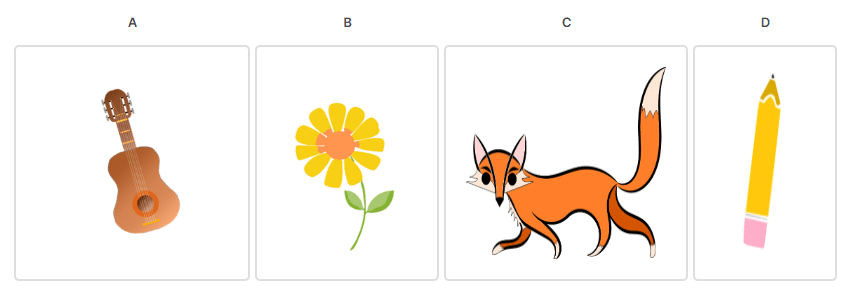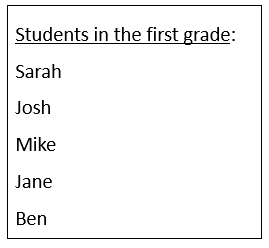MAP Kindergarten Reading Test: Free Practice, Prep Tips & Scores
Welcome to your comprehensive preparation guide for the MAP Kindergarten reading test section.
On this page, you’ll find everything needed to maximize your child’s reading score potential, including:
- An in-depth explanation of the test
- Free practice questions that resemble the actual test
- Overview & interpretation of the scores
- Actionable & fun preparation tips
So if you’d like to help your child prepare efficiently and increase their chances of scoring high, you’ll love this guide.
Let’s dive in!
What’s on This Page
What Is on the Reading MAP Test for Kindergarten?
The Reading section of the MAP Kindergarten test is designed to assess various aspects of your child’s literacy skills. With approximately 43 questions, the test covers various topics to evaluate their readiness for reading and comprehension.
While the test is untimed, the adaptive nature ensures that your child may encounter questions tailored to their level, potentially including content above their grade level.
It’s important to note that all questions are recorded, eliminating the need for concern if your child is not yet proficient in reading. If there are questions with more complex wording, your child can listen to them again as many times as needed. As a parent, you can support your child’s listening comprehension by reading them stories and engaging in discussions.
To get more valuable information about the MAP Kindergarten test, check our detailed guide.
Areas Covered on the MAP Kindergarten Reading Test
| Skill Type | Question Type | Example |
|---|---|---|
| Foundational Skills | Phonics and Word Recognition | Identify the vowel sound in the given word. |
| Phonological Awareness | Count the number of syllables in the given word. | |
| Print Concepts | Recognize the correct order of letters in a word. | |
| Literary and Informational Text | Meaning, Context, Craft, and Structure | Infer the meaning of a word based on the context. |
| Informational Text: Key Ideas, Details, Craft, Structure | Identify the main idea of the informational passage. | |
| Literature: Key Ideas, Craft, Structure | Describe the character’s traits in the story. | |
| Language and Writing | Capitalize, Spell, Punctuate | Correctly punctuate the given sentence. |
| Language: Grammar, Usage | Identify the correct usage of a pronoun. | |
| Text Types and Purposes, Research | Identify the purpose of a given piece of writing. | |
| Vocabulary Acquisition and Use | Word Meanings and Relationships | Determine the synonym of the given word. |
| Vocabulary Use and Functions | Choose the appropriate word to complete the sentence. | |
| Language: Context Clues and References | Use context clues to understand the meaning of a word. | |
| Vocabulary Acquisition and Use | Define the meaning of the given word. |
The table above provides an overview of the skills tested in the MAP Reading K-2 test, the corresponding question types, and quick examples to illustrate each question type.
Take a Free MAP Reading Kindergarten Practice Test
The sample test below is divided into easy, moderate, and difficult questions so that you can estimate your child’s level.
Easy Questions
Sample Question #1
Look at the signs. Choose the question mark:
A !
B .
C ?
D ,
Correct Answer & Explanation:
The correct answer is C.
The sign of a question mark is “?”
Answer A is incorrect because the sign “!” is an exclamation mark.
Answer B is incorrect because the sign “.” is a period.
Answer D is incorrect because the sign “,” is a comma.
Sample Question #2
Which word ends with the sound of the letter “X”?

Correct Answer & Explanation:
The correct answer is C.
The letter X makes the sound /ks/.
The picture in answer C is a fox, which ends with the sound /ks/.
Moderate Questions
Sample Question #1
How many syllables does the word “buffet” have?
A. 1
B. 2
C. 3
D. 4
Correct Answer & Explanation:
The correct answer is B.
To find the number of syllables in a word, count the number of times you hear the letters: ”a”, “e”, ”i”, “o”, “u”.
“buffet” has two syllables: buf-fet (you hear the sounds /a/, /e/).
Sample Question #2
Look at the following text:

What type of text is this?
A. Story
B. Poem
C. Letter
D. List
Correct Answer & Explanation:
The correct answer is D.
A list is a series of words or numbers, such as names of persons or objects.
A list is usually written with a single word on each line, so it’s easy to find a certain item.
The text above is a list of the names of the students in the first grade.
Difficult Questions
Sample Question #1
What is the plural form of the word mouse?
A. Mouses
B. Mousess
C. Mice
D. Mouse
Correct Answer & Explanation:
The correct answer is C.
In most nouns in English, the letter “s” at the end of a noun changes it from singular form (one) to plural form (more than one).
However, there are some irregular words with a different plural form, such as the word “mouse”.
The plural form of the word “mouse” is “mice”.
Sample Question #2
Look at the sentence that is missing a word:
I need to __ a birthday gift for my sister.
Which word completes the sentence?
A. by
B. bye
C. buy
Correct Answer & Explanation:
The correct answer is C.
The words “by”, “bye” and “buy” are examples of homophones, which are words that sound the same, but are spelled differently and have different meanings.
The word “buy” means to get something by paying money for it, so it completes this sentence: I need to buy a birthday gift for my sister.
Get 7 additional MAP Kindergarten Reading practice tests to improve your child’s abilities.
Understand the NWEA MAP Reading Scores for Kindergarten
The MAP (Measure of Academic Progress) Reading test for Kindergarten provides valuable insights into your child’s literacy skills. To comprehend the scores effectively, it’s essential to understand the calculation process, RIT scores, percentiles, and what constitutes high, median, and lower achievement.
How MAP Scores are Calculated:
The MAP test utilizes a unique scoring system known as RIT (Rasch Unit) scores. Unlike traditional tests that yield a percentage-based score, RIT scores measure a student’s academic growth over time. The RIT scale is a continuous scale that allows for precise tracking of a student’s progress, making it a dynamic and adaptive assessment tool.
Interpreting RIT Scores:
- High Achievement: A high RIT score indicates that a child is performing at an advanced level for their grade. It reflects a strong grasp of the tested skills and concepts.
- Median Achievement: A median RIT score suggests that a child’s performance aligns with the average expectations for their grade level. It indicates a solid understanding of the curriculum.
- Lower Achievement: A lower RIT score doesn’t necessarily imply academic struggle; it may signal areas where additional support or focus is beneficial. It’s an opportunity for targeted intervention to enhance learning.
Understanding Percentiles:
Percentiles provide a comparative measure of a student’s performance relative to their peers. For instance, if a child scores in the 75th percentile, it means they performed as well as or better than 75% of students in the same grade who took the test.
Decoding Achievement Levels:
- 90th Percentile and Above: Considered High Achievement. Your child is performing exceptionally well, demonstrating advanced skills.
- 40th to 60th Percentile: Reflects Median Achievement. Your child’s performance aligns with the average expectations for their grade level.
- Below 30th Percentile: Indicates Lower Achievement. This may suggest areas for improvement and targeted support.
See the table on this official PDF for specific grade-level RIT scores and percentiles.
Utilizing Scores for Support:
Understanding your child’s MAP Reading scores enables educators and parents to tailor support strategies. High achievement may warrant enrichment opportunities, while lower achievement may trigger interventions to address specific skill areas.
7 Fun Activities to Help Your Child Prepare for the Reading Section
1. Storytime Adventures:
- Activity: Set aside dedicated time for daily story sessions.
- Action: Read a variety of books, including fiction and non-fiction. Encourage your child to ask questions about the story and discuss characters, settings, and events.
2. Letter Treasure Hunt:
- Activity: Turn letter recognition into a game.
- Action: Hide letter cards around the house or in the yard. Give your child a “treasure map” with clues to find each letter. As they discover letters, say the corresponding sounds together.
3. Rhyme Time Challenge:
- Activity: Transform rhyming into a playful activity.
- Action: Choose a rhyming word and challenge your child to find objects that rhyme. For example, if the word is “cat,” they can find a hat or a mat. Make it a game and see how many rhymes they can discover.
4. Alphabet Art Collage:
- Activity: Combine creativity with letter recognition.
- Action: Provide magazines, newspapers, or printed materials. Help your child cut out pictures of objects that start with different letters. Create an alphabet art collage together, reinforcing both letter recognition and vocabulary.
5. Sensory Word Play:
- Activity: Engage multiple senses in learning words.
- Action: Use sensory materials like sand, rice, or playdough to write letters or simple words. Your child can trace the shapes with their fingers while saying the corresponding sounds. This multisensory approach enhances memory.
6. Adventure in Punctuation:
- Activity: Playfully introduce punctuation marks.
- Action: Create a “punctuation adventure” story. Use different voices and expressions for periods, question marks, and exclamation points. Your child can join in by adding the appropriate punctuation as you read together.
7. Word Building Blocks:
- Activity: Make word formation a hands-on experience.
- Action: Use building blocks or magnetic letters to form simple words. Encourage your child to arrange the letters correctly to create new words. This activity enhances spelling and reinforces the connection between letters and sounds.
These activities not only make learning enjoyable but also target specific skills assessed in the MAP Kindergarten Reading section. By incorporating these fun activities into your daily routine, you provide your child with valuable opportunities to develop and strengthen their literacy skills playfully.
